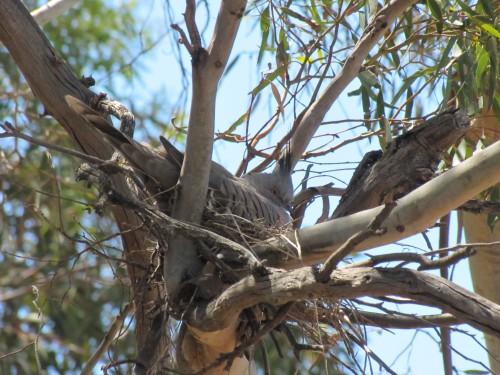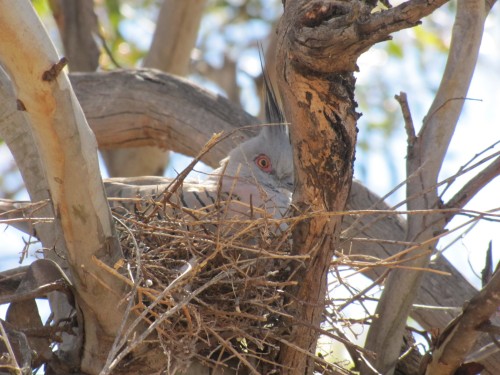Crested Pigeons nesting in our garden
On our return from a recent holiday in Sydney we were having lunch on the back veranda. I was watching a Crested Pigeon fussing about in a tree about twenty metres away. Next thing it settled down as if on a nest. I left my food – actually I think I was at the cuppa stage of the meal – and moved slowly and carefully towards the nest. I’d remembered to go inside to get my camera first.
Sure enough – the pigeon was sitting on a nest. Crested Pigeons are very common around Murray Bridge. At times I have counted up to 50 sitting perched on power lines, often in a row. It’s quite a spectacular sight, though it is not common to see so many at one location. Loose groups of 5 to 15 are quite common, however.
Crested Pigeons are what I call a resident breeding species, meaning, they are resident all the year and that they breed in our garden. The nest shown in today’s photos is quite a substantial nest for a pigeon. Most pigeons and doves are not fastidious or elaborate when it comes to nest building. They seem to think that a dozen or so flimsy sticks placed at random in the fork of any tree or bush will do as a home for their chicks. How the eggs don’t fall through some nests I’ve seen is amazing. Still, they seem to manage; there are a lot of them around!
My writing of this post was interrupted by the load of washing finishing, and I am the one in our household who usually does the washing. The pigeon’s nest is near the clothes line and the bird is sitting tight, even when we walk within a few metres of the nest. She must have eggs, I think. I will keep a watch on proceedings.
UPDATE: January 22nd: over the last week we have had a heatwave with five days over 42C with several over 45C (113F). This was followed by several days of wild wind which broke several branches off our trees. The nest is still there but appears to have been abandoned.
Horsfield’s Bronze-cuckoos
Over recent weeks we have heard one or two Horsfield’s Bronze-cuckoos calling from various vantage points on our property or nearby; their call usually carries well over a hundred metres. On one occasion I saw two in the tree shown in the photos here. One was chasing the other so I suspect that mating was imminent. The tree in question is about 40 metres from our back varanda.
Most of the various cuckoos in Australia are like the true cuckoos of Europe except for their call. They are parasitic breeders, laying their eggs in the nests of a wide range of host parents who then incubate the eggs, hatch and raise the young. In many cases the cuckoo will dispose of the host bird’s eggs, or the cuckoo chick will hatch first and remove the eggs or young as the hatch.
We also get the Pallid Cuckoo and the Fan-tailed Cuckoo in our area most spring times but I haven’t heard either of them yet this year. On only one occasion we had a Shining Bronze-cuckoo in our garden, and it is possible to have the Black-eared Cuckoo here too, but I’ve yet to record that species on our block of land.
related articles:
Cattle Egret, walk through aviary at Adelaide Zoo
I love visiting the walk-through aviaries at Adelaide Zoo. It enables me to get close up photos of many species I have trouble approaching closely enough for good photographic studies, like the one above. When one is only a few metres from a bird of this size (48-53cm high) and puts the zoom on the lens into action, amazing shots can result. The fine details of plumage come to life and the colours can be impressive. Please note that the photos on this post have not been altered in any way from the originals.
Cattle Egrets are widespread throughout northern and eastern Australia and parts of SW Western Australia. They are widespread in my part of South Australia but my experience of them is that they are not present in huge numbers here. They take on the beautiful orange plumage during breeding. I love the plumes on the back of the bird shown in the photo below (click to enlarge).
Pacific Black Ducklings pay us a visit
A few weeks ago I wrote about a pair of Pacific Black Ducks mating in our swimming pool. We have been waiting expectantly ever since for the arrival of a little band of ducklings. They usually head for our swimming pool, and then can’t get out again.
This has happened every year now for about 6 or 7 years. It’s possibly the same pair each year. Despite thorough searches we have been unable to locate the actual nest on every occasion. One of the problems they face is once they get into the pool, they are unable to get out. Very soon they can die of either hypothermia or drown (because their feathers are not yet water repellent).
To cater for this problem we have made a wooden framed ramp covered with wire netting. We usually throw an old towel over the netting and it doesn’t take the ducklings long to find out that this is a way out of the water.
This year it was a little different. Mother duck headed off across our small paddock with four ducklings in tow. One poor little fellow missed the on ramp and swam under it, causing him to be separated from his siblings. Trevor came to the rescue. While my wife watched the family movements I managed to scoop up the lost baby and then run after the mother and the other ducklings carrying the almost abandoned duckling. Soon they were reunited and on their way.
Not sure if they headed for the River Murray some 4 kilometres away, or stopped over at a storm water drainage dam about a kilometre over the paddock.
With all the excitement of the rescue attempt, I didn’t get a photo!
Baby Willie Wagtails come out to feed
I never did find where our resident pair of Willie Wagtails were nesting recently. Yesterday, however, I found the three lovely babies huddled together on a fence post. They looked as if they were just out of the comfort of their nest.
Of course – the parents didn’t like me getting too close and so I received a severe telling off as I was taking their photo.
Next time I probably should get the parents to sign a model release form – then they might be happier.











